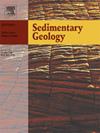巴西帕拉纳盆地早二叠世深水多源叶状杂岩的地层构型
IF 2.9
2区 地球科学
Q1 GEOLOGY
引用次数: 0
摘要
巴西帕拉南本文章由计算机程序翻译,如有差异,请以英文原文为准。
Stratigraphic architecture of a multi-sourced, Deepwater lobe complex (early Permian, Paraná basin, Brazil)
The Rio Segredo Member of the Taciba Formation (Paraná Basin, Brazil) represents a unique example of a multi-sourced turbidite lobe complex, providing valuable insights into the stratigraphic architecture and depositional processes of delta-fed submarine ramp systems. This study investigates the lobe complex, which extends over 120 km and reaches a thickness of up to 40 m, with a focus on bed type distribution, facies associations, and stratigraphic architecture. Through the analysis of 16 measured sections and detailed facies analysis, 14 distinct bed types were identified, including turbidites (TBDs), hybrid event beds (HEBs), and slump and blocky flow deposits (MTDs). These beds are organized into four sub-environments: lobe axis, lobe off-axis, lobe fringe, and distal lobe fringe, reflecting a compensational stacking pattern with lobe centroids shifting southward by an average of 25 km. Paleocurrent data indicates predominant flow directions to the northwest (320°) and southwest (235°), supporting the interpretation of a multi-sourced system. The lobe complex is interpreted as a delta-fed submarine ramp, with deposition driven by delta-front instabilities and hyperpycnal flows via conduits connected to prograding delta. Hybrid event beds, which are common in the basal sandy portion of the succession, are linked to substrate erosion and interactions with small-scale morphological highs, highlighting the influence of paleophysiography on flow dynamics. This study enhances the understanding of multi-sourced turbidite systems and provides a framework for identifying similar systems in other basins. The findings underscore the importance of autogenic controls, such as lobe avulsion and topographic compensation, in shaping the stratigraphic architecture of delta-fed turbidite systems.
求助全文
通过发布文献求助,成功后即可免费获取论文全文。
去求助
来源期刊

Sedimentary Geology
地学-地质学
CiteScore
5.10
自引率
7.10%
发文量
133
审稿时长
32 days
期刊介绍:
Sedimentary Geology is a journal that rapidly publishes high quality, original research and review papers that cover all aspects of sediments and sedimentary rocks at all spatial and temporal scales. Submitted papers must make a significant contribution to the field of study and must place the research in a broad context, so that it is of interest to the diverse, international readership of the journal. Papers that are largely descriptive in nature, of limited scope or local geographical significance, or based on limited data will not be considered for publication.
 求助内容:
求助内容: 应助结果提醒方式:
应助结果提醒方式:


